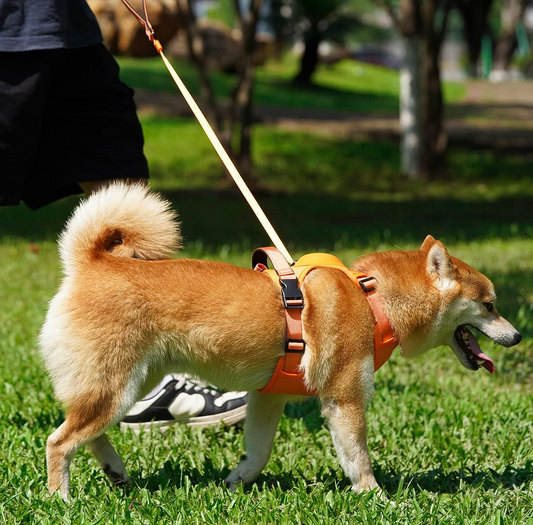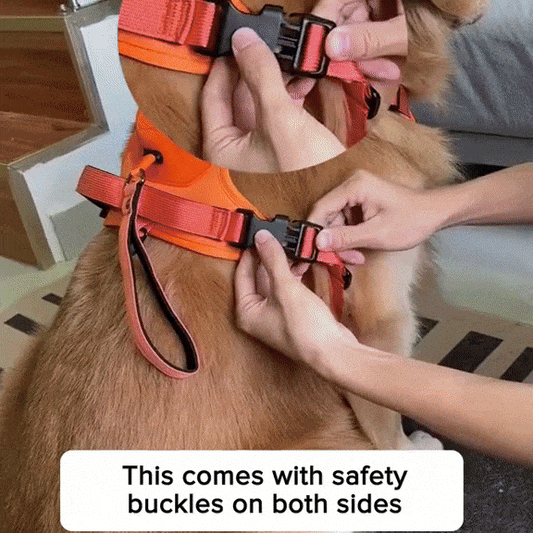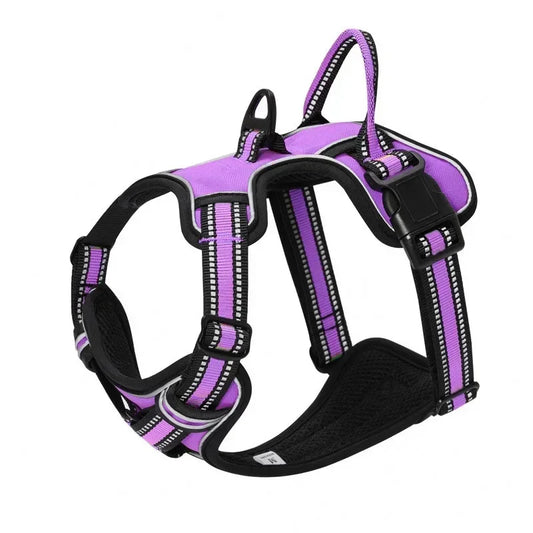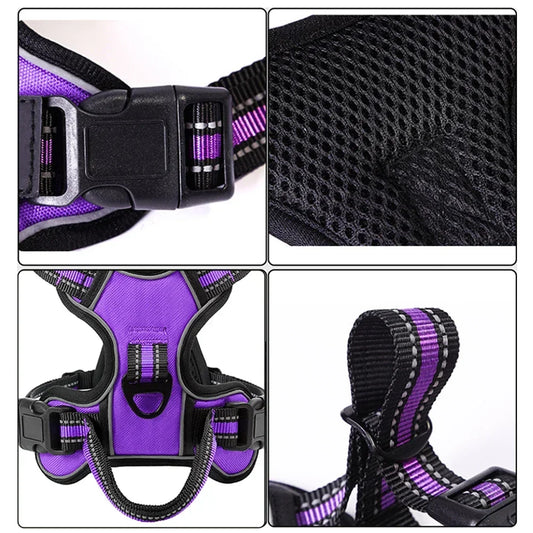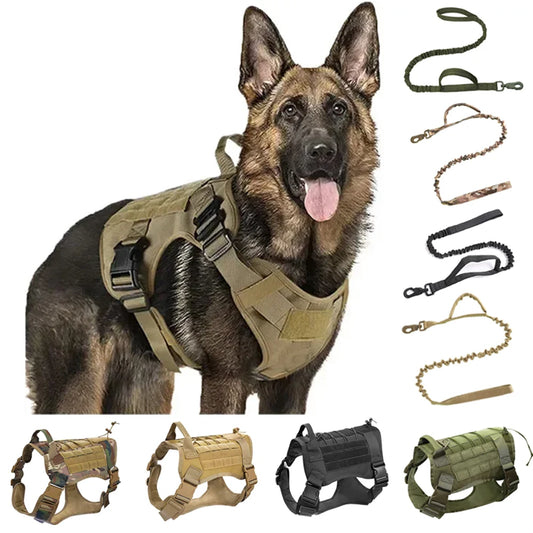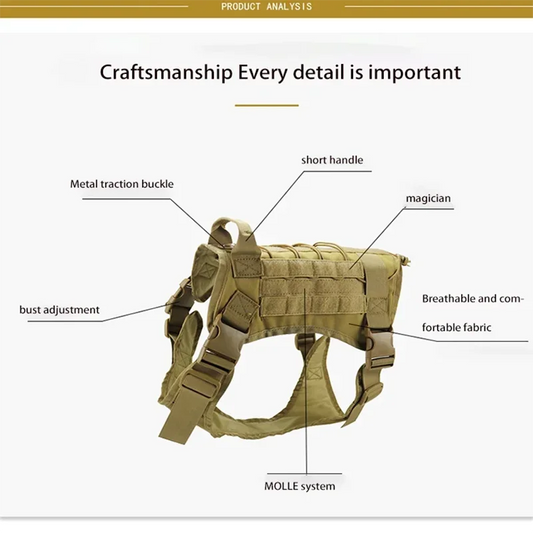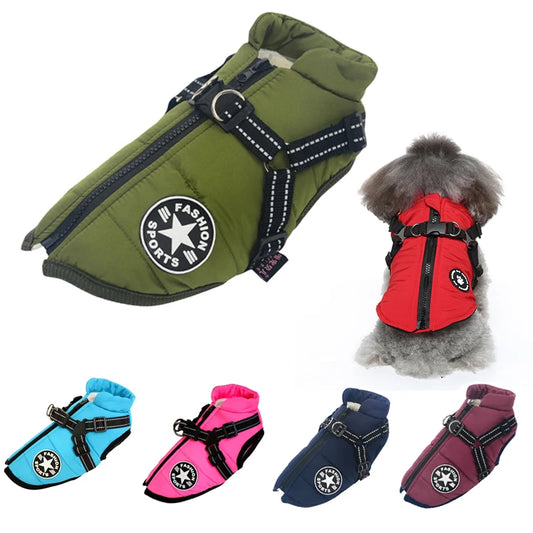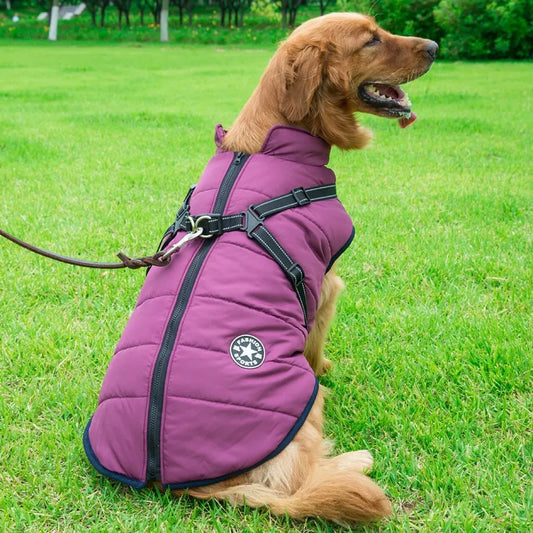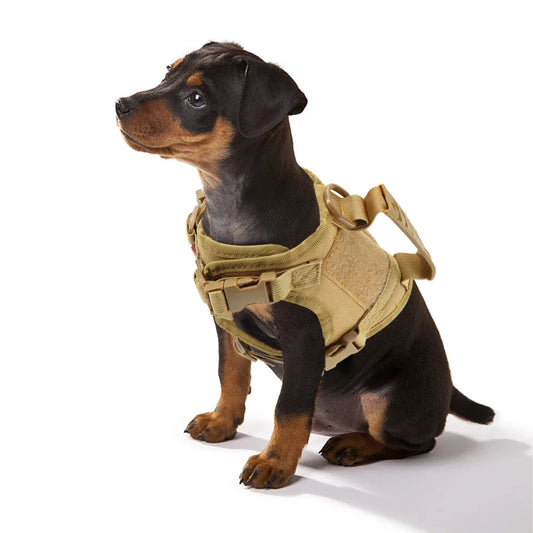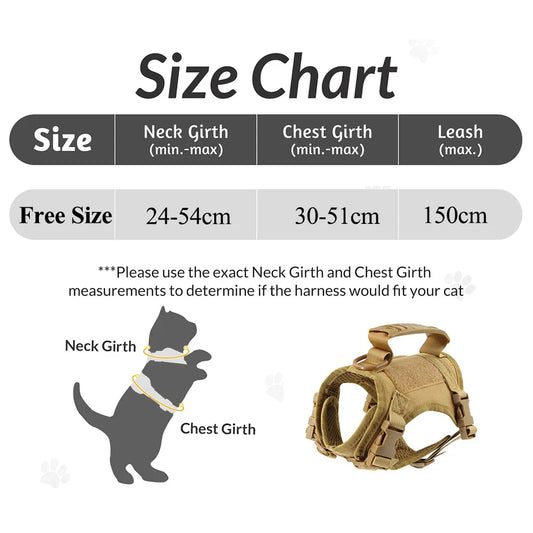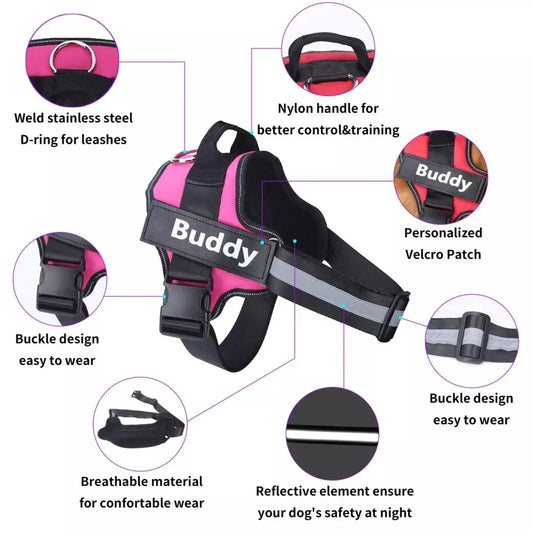Our range includes sets designed for dogs of all sizes and training needs. You will find combinations perfect for leash training sessions with stubborn pullers. We offer front attachment models that provide extra control for large dogs who tend to pull during daily walks.
In our assortment you will also find step-in harness sets perfect for small dogs and nervous pups or puppies.
The collection includes vest-style harnesses for added security and comfort. They feature chest plate designs with metal d rings for secure leash attachment points. We have also models that ensure safety during car rides and nighttime walks with your beloved pup. We focus on versatility and offer lightweight mesh harnesses with reflective elements for warmer weather, whether you’re taking regular walks or extended hiking adventures.
Padded, heavy-duty, escape-proof – the choice is yours, with options designed for extra comfort such as plush linings, making it easy for you to achieve a great fit and create walking experiences that earn 5 stars from both you and your dog. Dogs benefit from harnesses because weight distribution away from the neck can prevent injuries, especially in brachycephalic breeds (such as bulldogs or pugs) or fragile pups.
Do Dogs Walk Better with a Collar or Dog Harness? The Collar vs. Harness Debate
Collars are a classic dog accessory—practical, convenient, and great for ID tags in case your pup ever gets lost. But when it comes to walking your dog, collars may not always be the safest or most comfortable option.
Since collars sit around the neck, they can place pressure on sensitive areas like the windpipe and spine. Dogs that pull on the leash or get tugged suddenly can risk injury, especially smaller breeds or those with delicate necks. In some cases, dogs can even slip out of their collars—this is particularly common in slim-headed breeds like greyhounds or whippets.
That’s where dog harnesses come in.
Why Dog Harnesses Are Better for Walks
Unlike collars, a harness distributes pressure across your dog’s chest, shoulders, and back. This design not only makes walks more comfortable but also gives you better control—especially if your dog is strong, excitable, or still learning leash manners.
A good-quality dog harness also helps discourage pulling without risking injury. Whether your dog is large and energetic or small and stubborn, harnesses provide a safer, more secure walking experience for both of you.
Bottom line: Most dogs walk better with a harness, especially if they tend to pull or have any respiratory concerns.
Should I Use a Harness to Walk My Dog?
In most cases, yes. Dog harnesses are ideal for leash training, especially with puppies or newly adopted dogs. They reduce the chance of injury and give you more control without causing discomfort.
Some breeds—like pugs, bulldogs, and other flat-faced dogs—benefit greatly from harnesses because they’re prone to breathing issues. A harness avoids putting pressure on the throat, which helps prevent choking and tracheal collapse.
There are different styles of harnesses too:
-
Back-clip harnesses offer a relaxed walking experience for calm dogs.
-
Front-clip harnesses give more steering control, perfect for strong pullers or training sessions.
Do Harnesses Make Dogs Pull More?
It’s a common myth that harnesses encourage pulling—but it’s not true. In fact, most harnesses are designed to reduce pulling.
A properly fitted harness doesn’t create tension on your dog’s neck, which actually makes them feel more comfortable and less reactive. Plus, with front-clip designs, you can gently redirect your dog’s movement without the need for harsh corrections.
With patience and consistency, a harness can be an excellent tool for teaching leash manners—without causing discomfort or injury.
Do Dog Harnesses Restrict Movement?
They shouldn’t—if you choose the right one.
Poorly designed dog harnesses can restrict your dog’s shoulder movement, especially if the straps are placed too close to their front legs. This can impact your dog’s gait over time or cause discomfort.
When shopping for a harness, consider your dog’s breed, size, and build. Look for ergonomic designs that allow a full range of motion and won’t interfere with natural movement. Always test the fit and adjust straps as needed.
How to Put a Harness on Your Dog
Putting on a dog harness can feel tricky at first, but it gets easier with practice—and a calm dog helps a lot!
Here’s a basic step-by-step guide:
- Calm your dog first, either by waiting for them to settle or using treats to create a positive vibe.
- Depending on the style, slip the harness over their head or guide their front legs through the openings.
- Adjust the straps so it sits snugly—but not too tight. You should be able to fit two fingers between the harness and your dog’s body.
- Ensure the D-ring is in the right position, either on the back or chest, depending on the clip type.
Some harnesses are more complex than others, but the key is a proper fit. A well-fitted harness equals a happy, safe dog on every walk.
What is the best Dog Harness for Perfect Fit?
We’ve taken care of variety in our best dog harnesses, so it’s easy to find equipment that works with your dog’s specific needs—including finding a harness that fits your dog's body shape and size. It's important to carefully measure your dog to ensure the harness fits well, relying on measurements rather than weight.
Check out our sizing guide here
If you have small dogs with delicate necks, opt for a set with step-in design and side release buckles. This eliminates pressure on your dog's neck while providing a secure fit that’s more comfortable than just a collar and avoids strain on the dog's neck.
Is your challenge a large dog that pulls constantly? You need a front attachment harness that redirects pulling energy rather than fighting against it. These working dogs require extra control through dual leash attachment points that distribute pressure across the chest instead of the dog's head, ensuring the harness does not put pressure on the dog's head for added comfort and safety. A front-clip harness is recommended to dissuade dogs from pulling because it guides them to the side when they pull. Keep in mind, harnesses tend to increase leash tension if not used with proper training, especially for strong pullers.
Want maximum comfort during long walks? Choose harnesses with padded chest plates and adjustable straps. Adjusting the strap is easy, allowing you to achieve a secure fit for your dog's body. You’ll get the right fit when you can slide two fingers under the neck buckle without it being too tight. A well-fitted harness does not cause trauma to the armpits and should not show signs of redness or chafing.
Problems with escape artists? Opt for harnesses with multiple d rings and reinforced plastic buckles that prevent your pup from slipping free during walks. Many harnesses have adjustable straps for a customizable fit that can accommodate changes in size or coat length.
For dogs with special needs or service roles, vest-style harnesses and vests offer practical features like identification and support, making them ideal for both safety and convenience.
How to use them for daily walks?
A well-fitted harness can make a big difference in how your dog is walked, improving control and comfort for both you and your pet. The back clip design works perfectly for trained dogs who walk calmly beside you, allowing natural movement while maintaining connection through the regular leash. For puppies still learning leash training, start with shorter sessions to help them adjust to wearing the harness without discomfort. During warmer weather, choose breathable mesh designs that prevent overheating while providing adequate control. The chest positioning distributes force across your dog's body rather than concentrating pressure on sensitive areas like the neck, ensuring your dog's comfort and safety during walks. Many customers find that adding dog tags directly to the harness d rings keeps identification secure even if the collar shifts during active play. Remember to keep adjusting the straps regularly as your pup grows, ensuring you can always fit two fingers between the harness and your pet’s skin for optimal comfort.
How to maximize control during training?
Training sessions require equipment that enhances communication between you and your dog while prioritizing safety. Front attachment harnesses excel during dog training because they naturally redirect your dog’s forward momentum when they pull, making corrections gentler yet more effective than traditional collar-based methods. The dual attachment points allow you to connect a regular leash to either the chest or back clip depending on your training goals.
For big dogs with strong pulling instincts, the front legs positioning helps you guide direction without creating opposition that encourages more pulling behavior. These harnesses are designed to fit securely around your dog's body, distributing force evenly to provide maximum control and comfort during training. Working dogs and service dog candidates benefit from harnesses with additional pockets for treats and training tools, keeping your hands free to focus on commands and rewards. Quality training harnesses feature sturdy construction that withstands repeated use while maintaining their secure fit, ensuring consistent results as your dog progresses through different training phases.
What materials and design ensure great quality?
A great dog harness isn’t just about control—it’s about long-lasting comfort, safety, and durability. The quality of materials and thoughtful construction both play a key role. Here's what to look for:
✅ Top Materials for High-Quality Dog Harnesses
-
Nylon Webbing
Durable, flexible, and soft against your dog’s skin. Nylon offers strong resistance to pulling while being lightweight and comfortable. It also holds up well in all weather conditions and resists mildew and moisture buildup. -
Oxford Fabric or Polyester Blend
Often used as a padded outer layer for added comfort and durability. These materials are breathable, water-resistant, and ideal for active dogs or long walks. -
Neoprene Padding
Common in premium harnesses, neoprene adds a layer of cushion to reduce chafing and discomfort—especially around sensitive areas like the chest and underarms. -
Mesh Lining
For breathability during warm weather, mesh helps regulate heat and keeps your dog cool during walks or play. -
Heavy-Duty Metal Hardware
Look for rust-resistant stainless steel or zinc-alloy D-rings and buckles. These are essential for strength, especially in leash connection points, and prevent breakage under tension.
🔧 Key Design Features That Indicate Quality
-
Reinforced Stitching
Quality harnesses include double or triple stitching at stress points—particularly where the leash clips in. This reduces the risk of tearing if your dog pulls suddenly. -
Sturdy Grab Handle
An integrated top handle offers added control in high-traffic areas or during training. It’s a valuable safety feature, especially for large or reactive dogs. -
Adjustable Fit Points
A high-quality harness should have multiple adjustment straps (usually 3-5) to fit your dog’s shape precisely and ensure comfort during long wear. -
Quick-Release Buckles
Strong plastic or metal quick-release buckles should be easy to use yet secure enough not to come undone by accident. -
Reflective Stitching or Trim
For added visibility during early morning or nighttime walks, look for reflective strips or piping sewn into the harness.
Check out our best selling dog harnesses here:

